Select
Overview
The select component allows you to select from a list of predefined options:
use Filament\Forms\Components\Select;
Select::make('status')
->options([
'draft' => 'Draft',
'reviewing' => 'Reviewing',
'published' => 'Published',
])
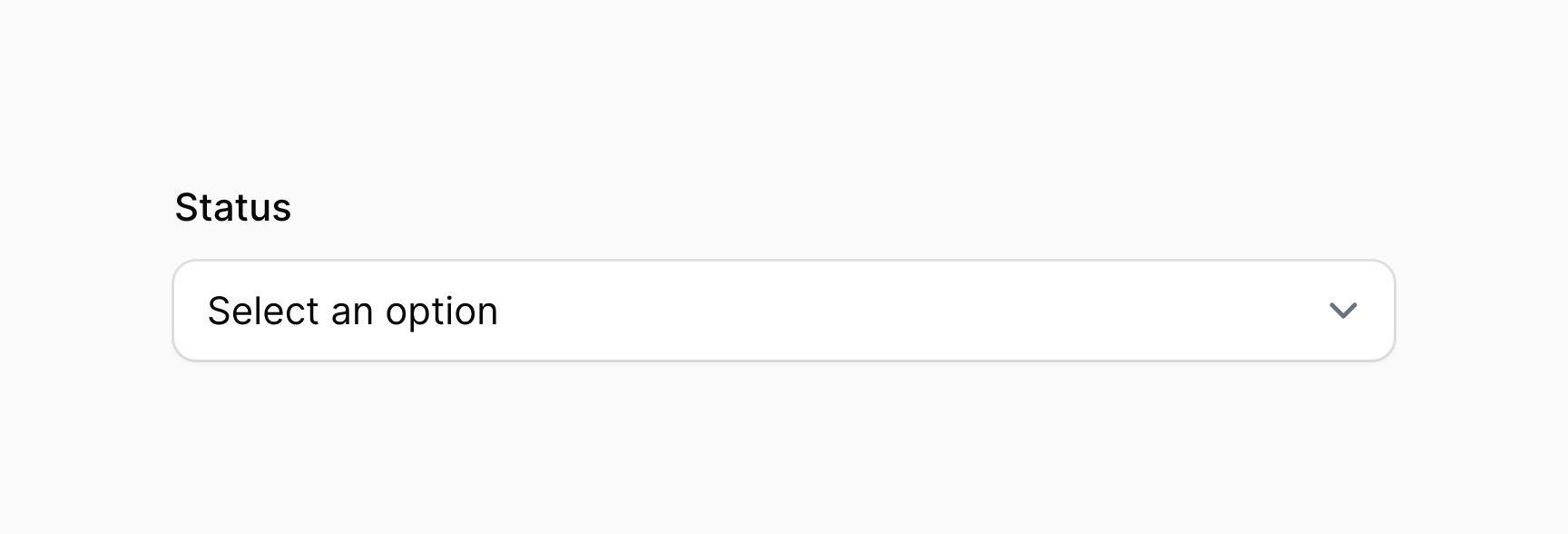
Enabling the JavaScript select
By default, Filament uses the native HTML5 select. You may enable a more customizable JavaScript select using the native(false) method:
use Filament\Forms\Components\Select;
Select::make('status')
->options([
'draft' => 'Draft',
'reviewing' => 'Reviewing',
'published' => 'Published',
])
->native(false)
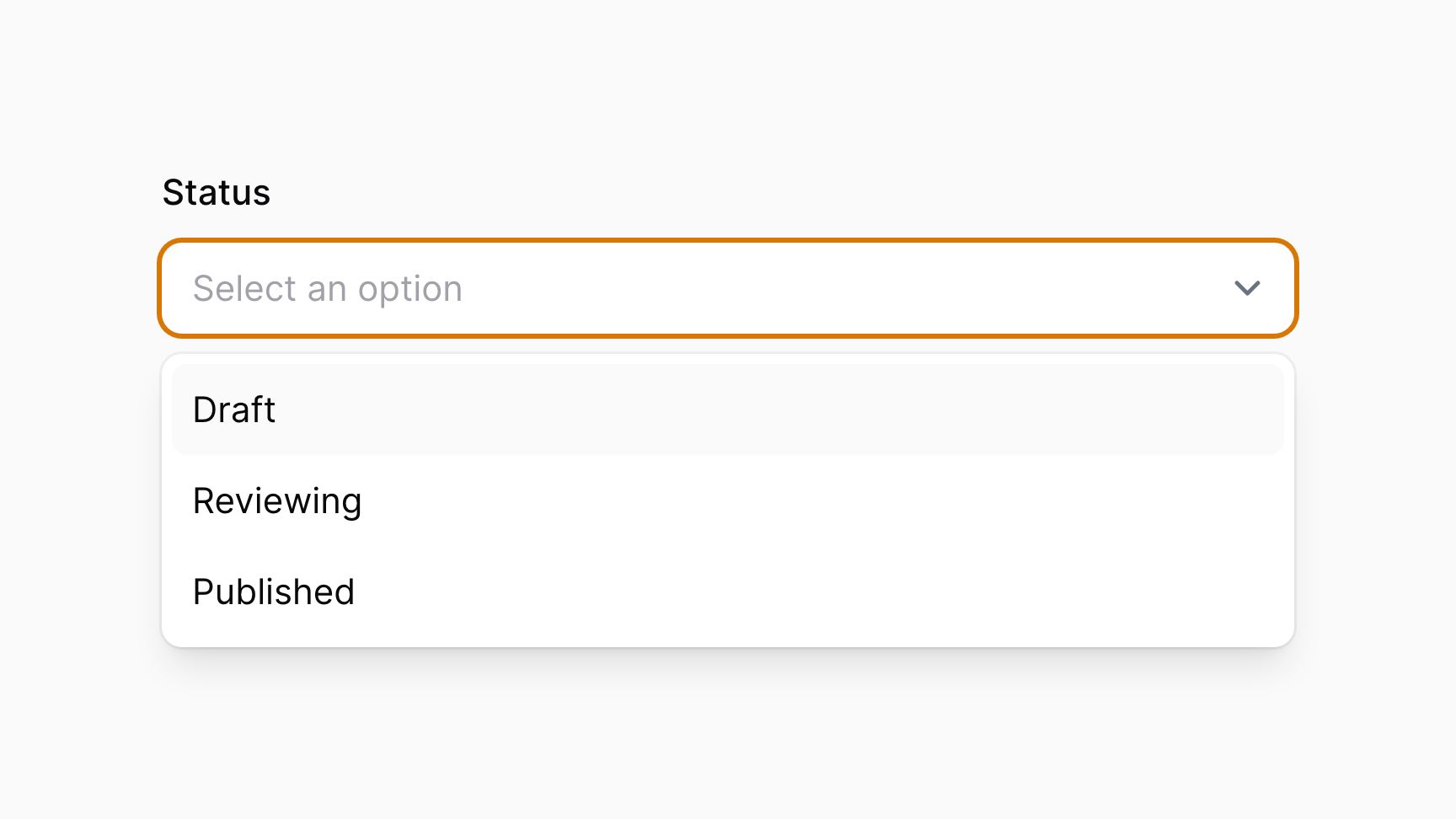
Searching options
You may enable a search input to allow easier access to many options, using the searchable() method:
use Filament\Forms\Components\Select;
Select::make('author_id')
->label('Author')
->options(User::all()->pluck('name', 'id'))
->searchable()
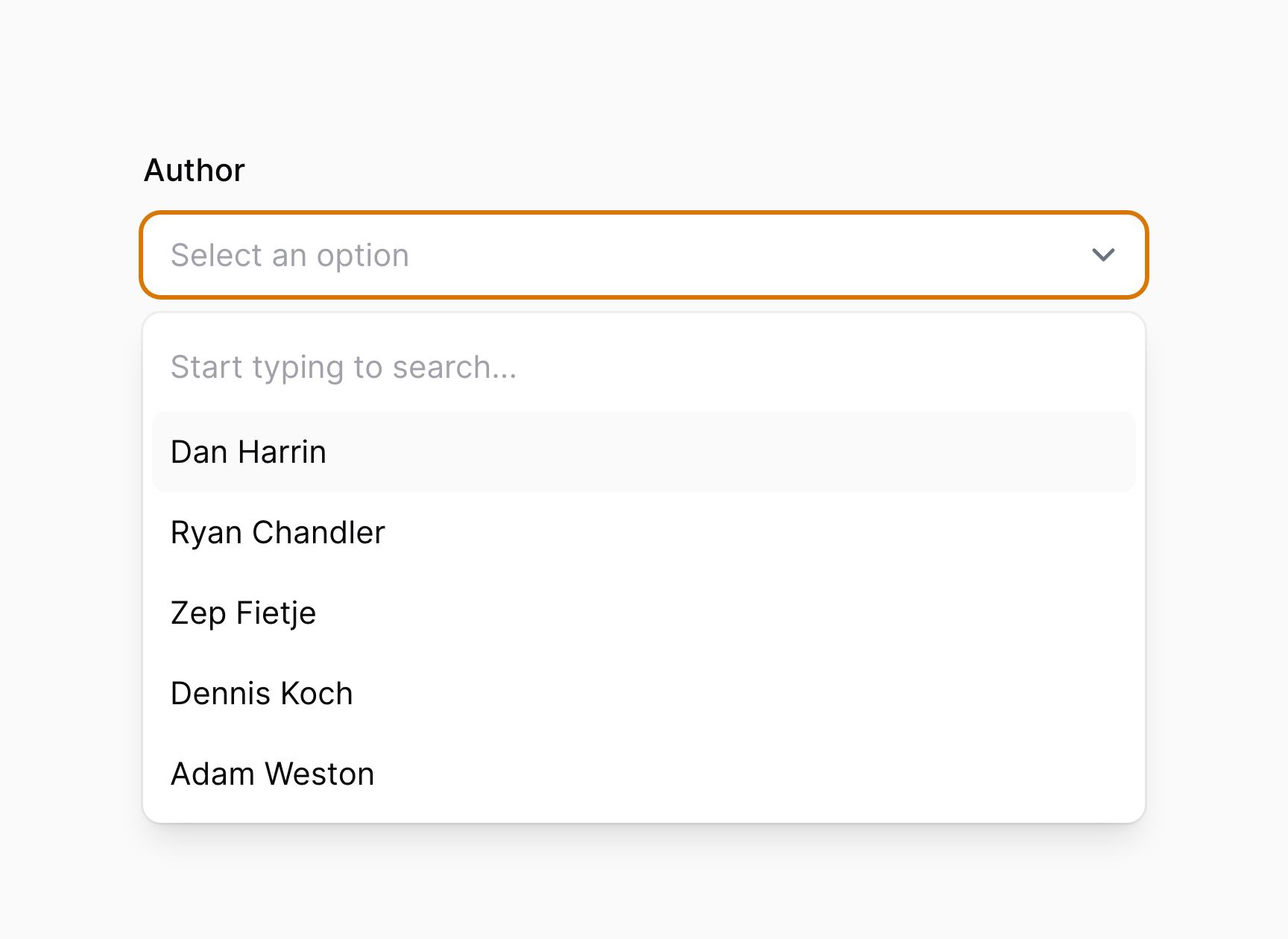
Returning custom search results
If you have lots of options and want to populate them based on a database search or other external data source, you can use the getSearchResultsUsing() and getOptionLabelUsing() methods instead of options().
The getSearchResultsUsing() method accepts a callback that returns search results in $key => $value format. The current user's search is available as $search, and you should use that to filter your results.
The getOptionLabelUsing() method accepts a callback that transforms the selected option $value into a label. This is used when the form is first loaded when the user has not made a search yet. Otherwise, the label used to display the currently selected option would not be available.
Both getSearchResultsUsing() and getOptionLabelUsing() must be used on the select if you want to provide custom search results:
Select::make('author_id')
->searchable()
->getSearchResultsUsing(fn (string $search): array => User::where('name', 'like', "%{$search}%")->limit(50)->pluck('name', 'id')->toArray())
->getOptionLabelUsing(fn ($value): ?string => User::find($value)?->name),
Multi-select
The multiple() method on the Select component allows you to select multiple values from the list of options:
use Filament\Forms\Components\Select;
Select::make('technologies')
->multiple()
->options([
'tailwind' => 'Tailwind CSS',
'alpine' => 'Alpine.js',
'laravel' => 'Laravel',
'livewire' => 'Laravel Livewire',
])
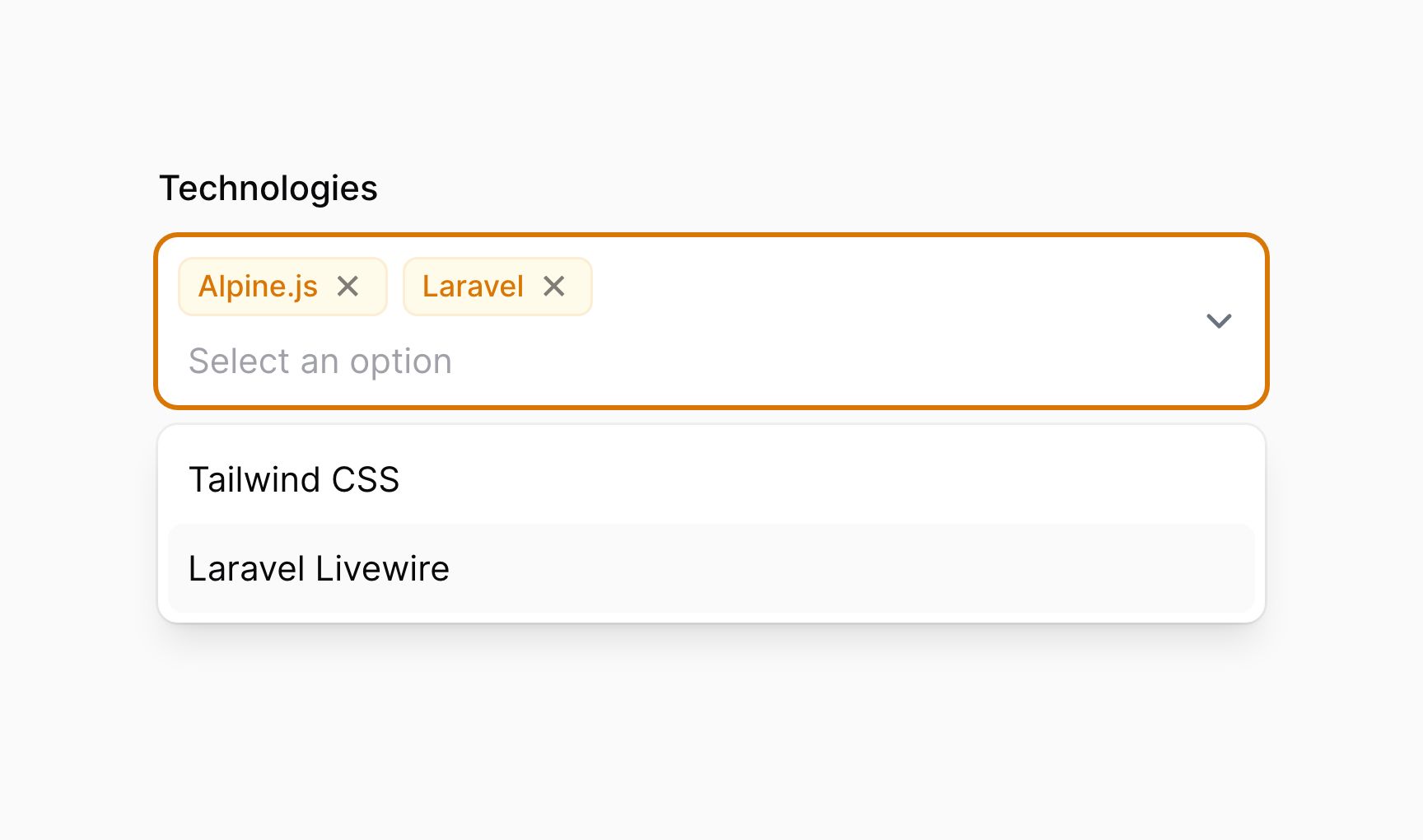
These options are returned in JSON format. If you're saving them using Eloquent, you should be sure to add an array cast to the model property:
use Illuminate\Database\Eloquent\Model;
class App extends Model
{
protected $casts = [
'technologies' => 'array',
];
// ...
}
If you're returning custom search results, you should define getOptionLabelsUsing() instead of getOptionLabelUsing(). $values will be passed into the callback instead of $value, and you should return a $key => $value array of labels and their corresponding values:
Select::make('technologies')
->multiple()
->searchable()
->getSearchResultsUsing(fn (string $search): array => Technology::where('name', 'like', "%{$search}%")->limit(50)->pluck('name', 'id')->toArray())
->getOptionLabelsUsing(fn (array $values): array => Technology::whereIn('id', $values)->pluck('name', 'id')->toArray()),
Grouping options
You can group options together under a label, to organize them better. To do this, you can pass an array of groups to options() or wherever you would normally pass an array of options. The keys of the array are used as group labels, and the values are arrays of options in that group:
use Filament\Forms\Components\Select;
Select::make('status')
->searchable()
->options([
'In Process' => [
'draft' => 'Draft',
'reviewing' => 'Reviewing',
],
'Reviewed' => [
'published' => 'Published',
'rejected' => 'Rejected',
],
])
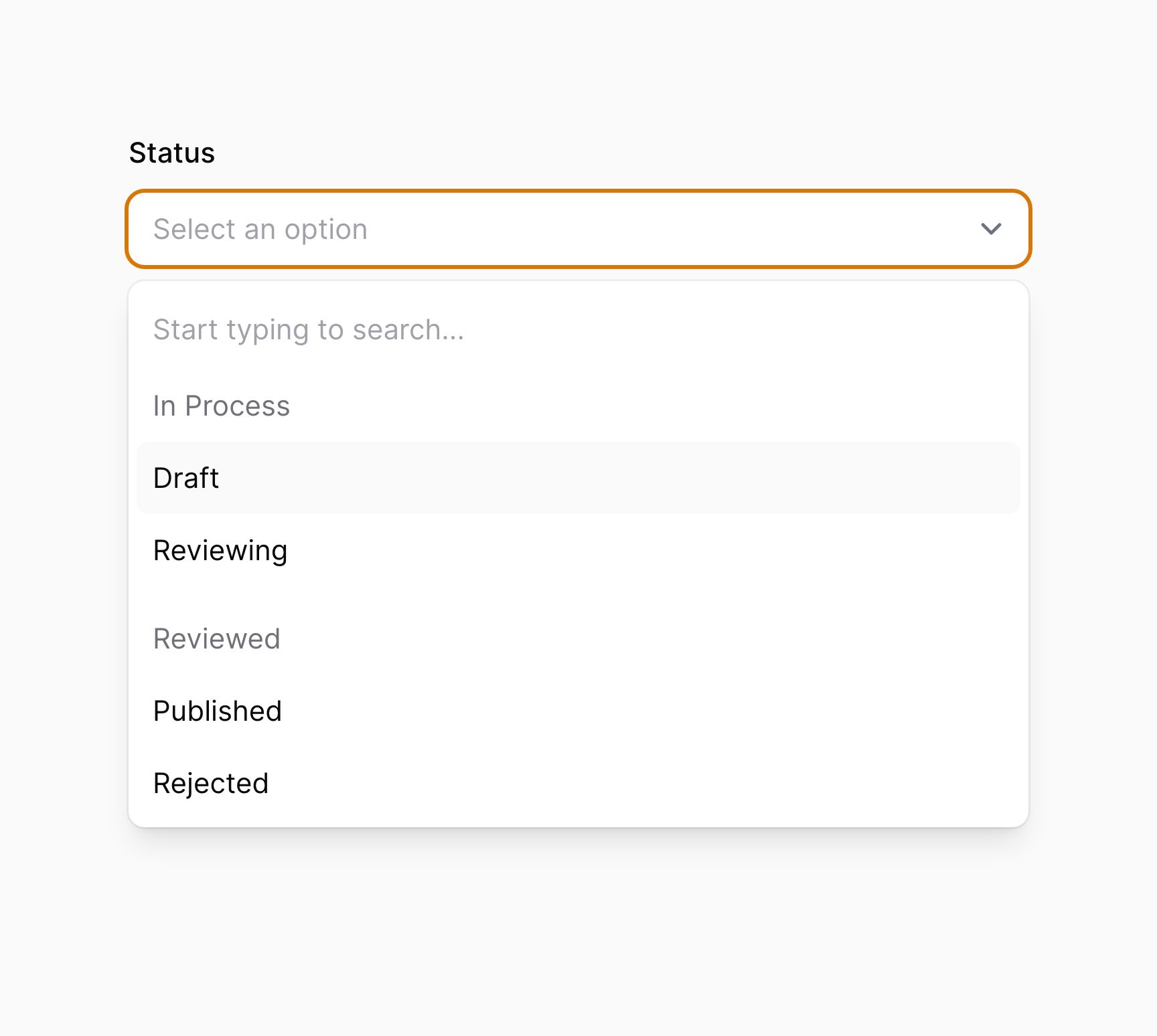
Integrating with an Eloquent relationship
If you're building a form inside your Livewire component, make sure you have set up the form's model. Otherwise, Filament doesn't know which model to use to retrieve the relationship from.
You may employ the relationship() method of the Select to configure a BelongsTo relationship to automatically retrieve options from. The titleAttribute is the name of a column that will be used to generate a label for each option:
use Filament\Forms\Components\Select;
Select::make('author_id')
->relationship(name: 'author', titleAttribute: 'name')
The multiple() method may be used in combination with relationship() to use a BelongsToMany relationship. Filament will load the options from the relationship, and save them back to the relationship's pivot table when the form is submitted. If a name is not provided, Filament will use the field name as the relationship name:
use Filament\Forms\Components\Select;
Select::make('technologies')
->multiple()
->relationship(titleAttribute: 'name')
Searching relationship options across multiple columns
By default, if the select is also searchable, Filament will return search results for the relationship based on the title column of the relationship. If you'd like to search across multiple columns, you can pass an array of columns to the searchable() method:
use Filament\Forms\Components\Select;
Select::make('author_id')
->relationship(name: 'author', titleAttribute: 'name')
->searchable(['name', 'email'])
Preloading relationship options
If you'd like to populate the searchable options from the database when the page is loaded, instead of when the user searches, you can use the preload() method:
use Filament\Forms\Components\Select;
Select::make('author_id')
->relationship(name: 'author', titleAttribute: 'name')
->searchable()
->preload()
Customizing the relationship query
You may customize the database query that retrieves options using the third parameter of the relationship() method:
use Filament\Forms\Components\Select;
use Illuminate\Database\Eloquent\Builder;
Select::make('author_id')
->relationship(
name: 'author',
titleAttribute: 'name',
modifyQueryUsing: fn (Builder $query) => $query->withTrashed(),
)
Customizing the relationship option labels
If you'd like to customize the label of each option, maybe to be more descriptive, or to concatenate a first and last name, you could use a virtual column in your database migration:
$table->string('full_name')->virtualAs('concat(first_name, \' \', last_name)');
use Filament\Forms\Components\Select;
Select::make('author_id')
->relationship(name: 'author', titleAttribute: 'full_name')
Alternatively, you can use the getOptionLabelFromRecordUsing() method to transform an option's Eloquent model into a label:
use Filament\Forms\Components\Select;
use Illuminate\Database\Eloquent\Builder;
use Illuminate\Database\Eloquent\Model;
Select::make('author_id')
->relationship(
name: 'author',
modifyQueryUsing: fn (Builder $query) => $query->orderBy('first_name')->orderBy('last_name'),
)
->getOptionLabelFromRecordUsing(fn (Model $record) => "{$record->first_name} {$record->last_name}")
->searchable(['first_name', 'last_name'])
Creating a new option in a modal
You may define a custom form that can be used to create a new record and attach it to the BelongsTo relationship:
use Filament\Forms\Components\Select;
use Illuminate\Database\Eloquent\Model;
Select::make('author_id')
->relationship(name: 'author', titleAttribute: 'name')
->createOptionForm([
Forms\Components\TextInput::make('name')
->required(),
Forms\Components\TextInput::make('email')
->required()
->email(),
]),
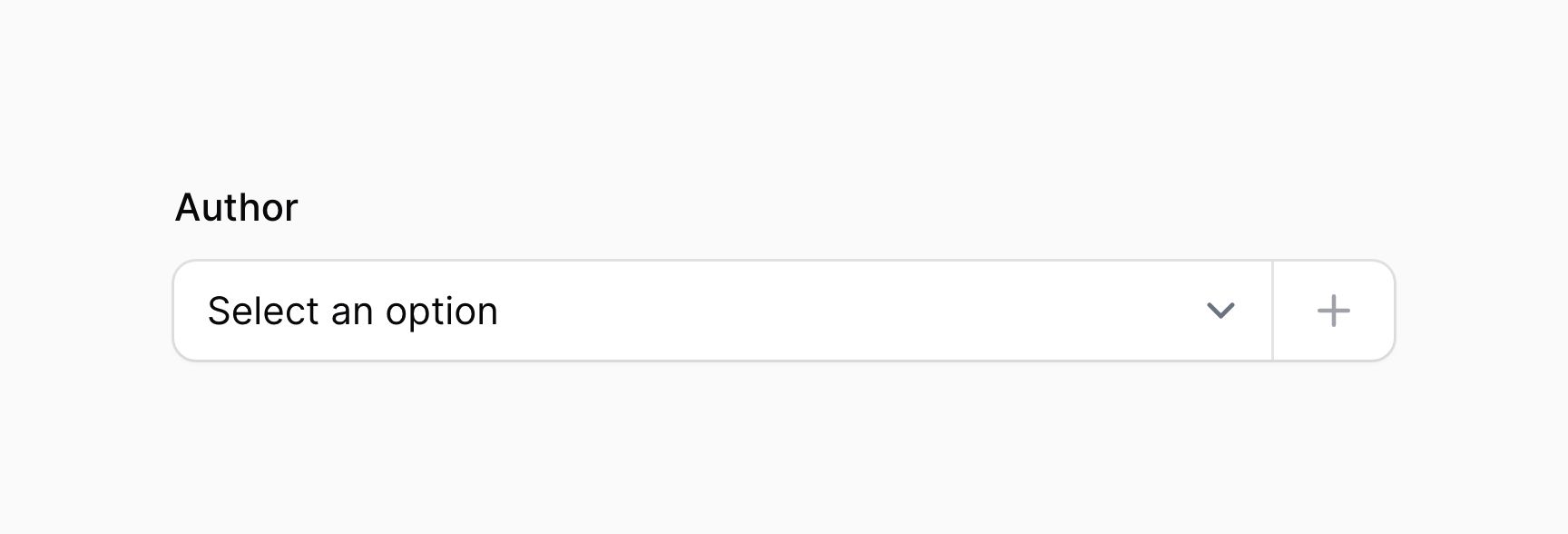
The form opens in a modal, where the user can fill it with data. Upon form submission, the new record is selected by the field.
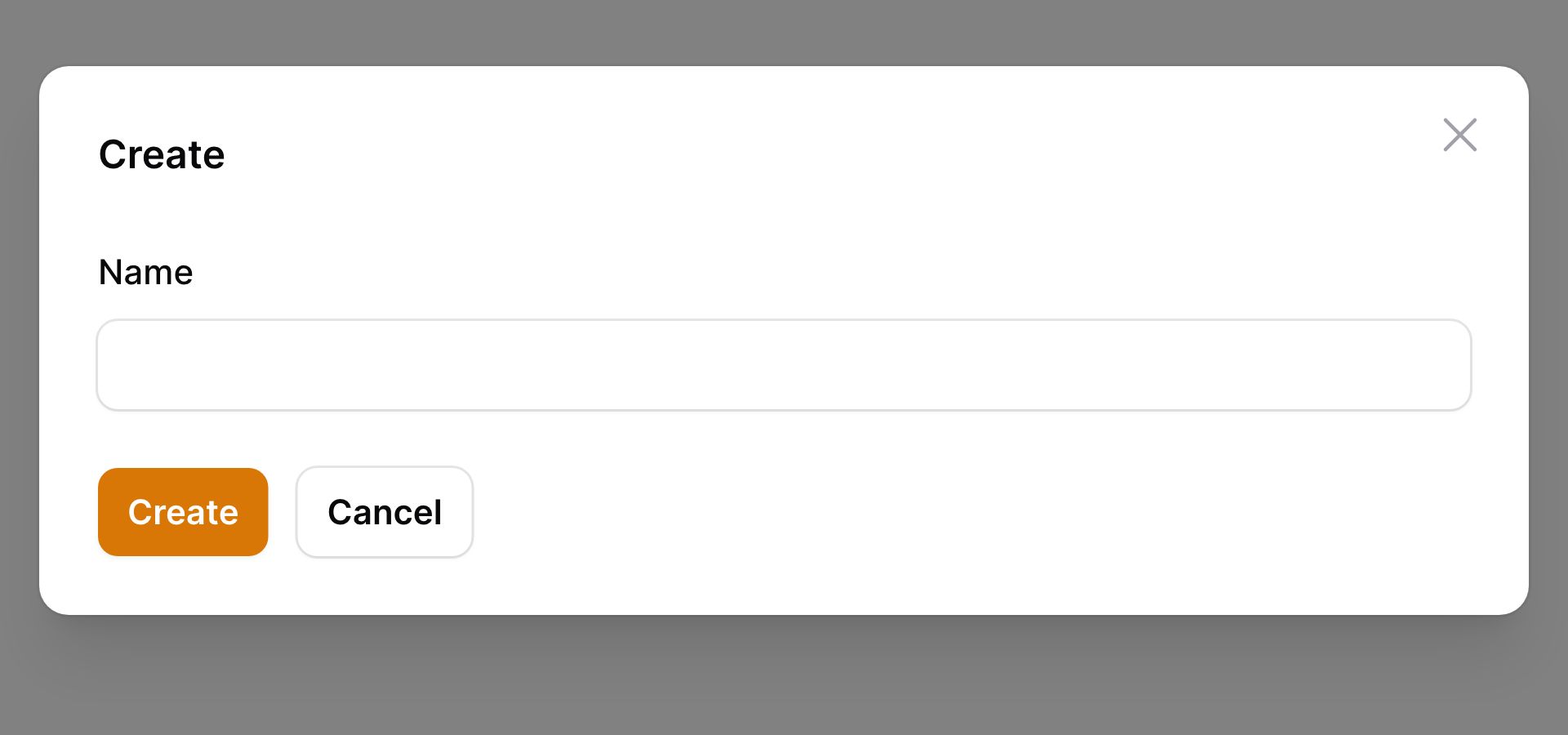
Editing the selected option in a modal
You may define a custom form that can be used to edit the selected record and save it back to the BelongsTo relationship:
use Filament\Forms\Components\Select;
use Illuminate\Database\Eloquent\Model;
Select::make('author_id')
->relationship(name: 'author', titleAttribute: 'name')
->editOptionForm([
Forms\Components\TextInput::make('name')
->required(),
Forms\Components\TextInput::make('email')
->required()
->email(),
]),
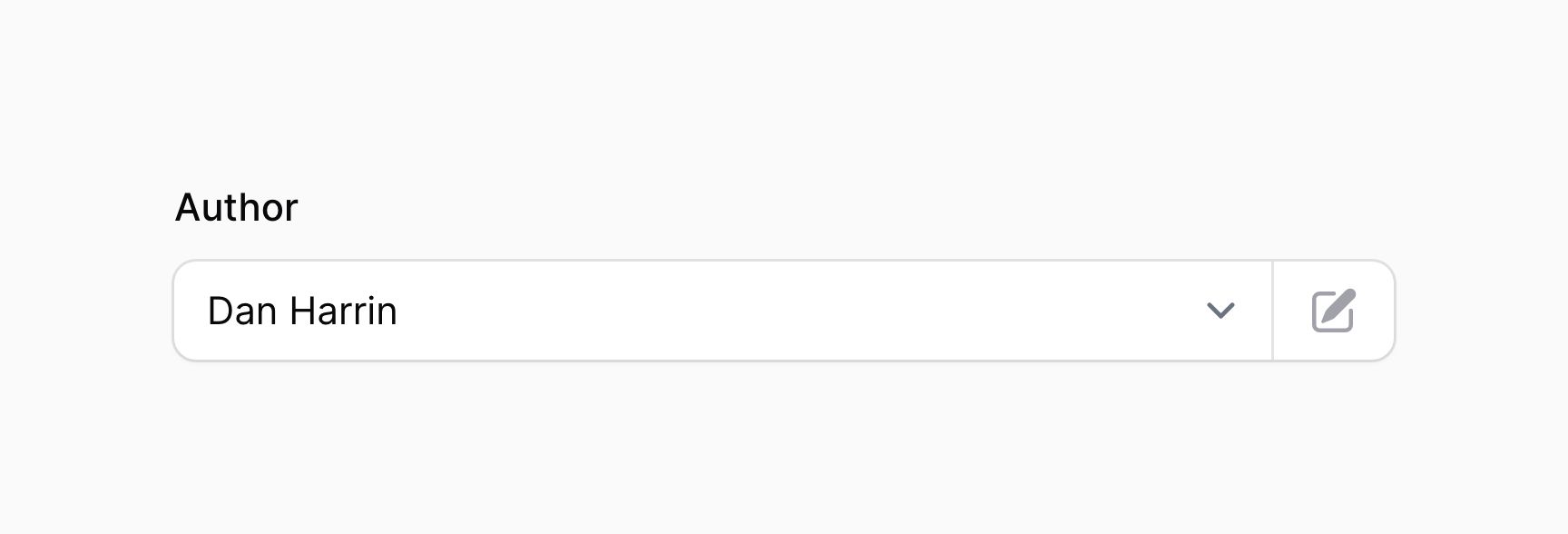
The form opens in a modal, where the user can fill it with data. Upon form submission, the data from the form is saved back to the record.
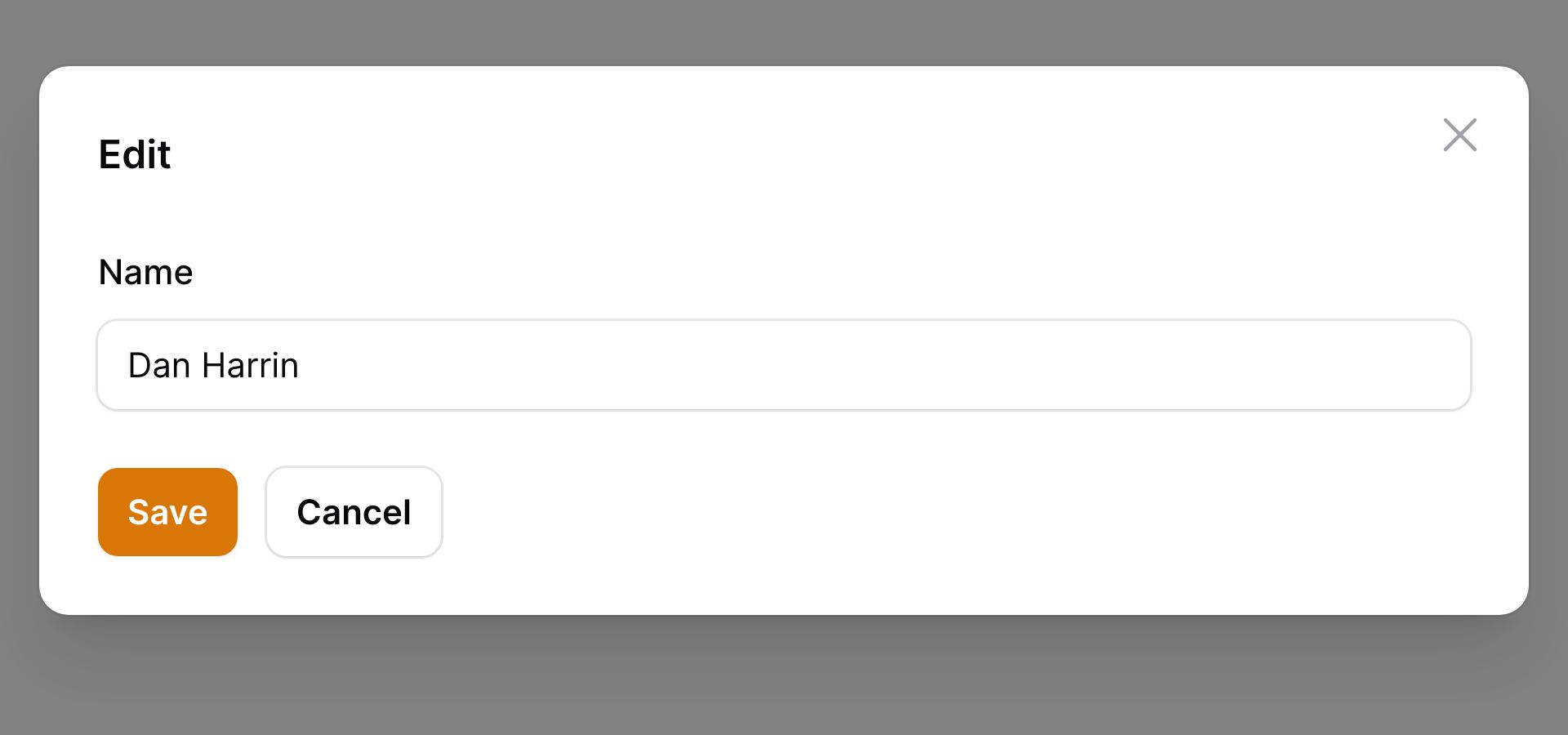
Handling MorphTo relationships
MorphTo relationships are special, since they give the user the ability to select records from a range of different models. Because of this, we have a dedicated MorphToSelect component which is not actually a select field, rather 2 select fields inside a fieldset. The first select field allows you to select the type, and the second allows you to select the record of that type.
To use the MorphToSelect, you must pass types() into the component, which tell it how to render options for different types:
use Filament\Forms\Components\MorphToSelect;
MorphToSelect::make('commentable')
->types([
MorphToSelect\Type::make(Product::class)
->titleAttribute('name'),
MorphToSelect\Type::make(Post::class)
->titleAttribute('title'),
])
Customizing the option labels for each morphed type
The titleAttribute() is used to extract the titles out of each product or post. If you'd like to customize the label of each option, you can use the getOptionLabelFromRecordUsing() method to transform the Eloquent model into a label:
use Filament\Forms\Components\MorphToSelect;
MorphToSelect::make('commentable')
->types([
MorphToSelect\Type::make(Product::class)
->getOptionLabelFromRecordUsing(fn (Product $record): string => "{$record->name} - {$record->slug}"),
MorphToSelect\Type::make(Post::class)
->titleAttribute('title'),
])
Customizing the relationship query for each morphed type
You may customize the database query that retrieves options using the modifyOptionsQueryUsing() method:
use Filament\Forms\Components\MorphToSelect;
use Illuminate\Database\Eloquent\Builder;
MorphToSelect::make('commentable')
->types([
MorphToSelect\Type::make(Product::class)
->titleAttribute('name')
->modifyOptionsQueryUsing(fn (Builder $query) => $query->whereBelongsTo($this->team)),
MorphToSelect\Type::make(Post::class)
->titleAttribute('title')
->modifyOptionsQueryUsing(fn (Builder $query) => $query->whereBelongsTo($this->team)),
])
Many of the same options in the select field are available for
MorphToSelect, includingsearchable(),preload(),allowHtml(), andoptionsLimit().
Forcing case-insensitive search
By default, searching will use the sensitivity settings from the database table column. This is to avoid unnecessary performance overhead when searching large datasets that would arise if we were to force insensitivity for all users. However, if your database does not search case-insensitively by default, you can force it to by using the forceSearchCaseInsensitive() method:
use Filament\Forms\Components\Select;
Select::make('author_id')
->relationship(name: 'author', titleAttribute: 'name')
->searchable()
->forceSearchCaseInsensitive()
Allowing HTML in the option labels
By default, Filament will escape any HTML in the option labels. If you'd like to allow HTML, you can use the allowHtml() method:
use Filament\Forms\Components\Select;
Select::make('technology')
->options([
'tailwind' => '<span class="text-blue-500">Tailwind</span>',
'alpine' => '<span class="text-green-500">Alpine</span>',
'laravel' => '<span class="text-red-500">Laravel</span>',
'livewire' => '<span class="text-pink-500">Livewire</span>',
])
->searchable()
->allowHtml()
Be aware that you will need to ensure that the HTML is safe to render, otherwise your application will be vulnerable to XSS attacks.
Disable placeholder selection
You can prevent the placeholder (null option) from being selected using the selectablePlaceholder() method:
use Filament\Forms\Components\Select;
Select::make('status')
->options([
'draft' => 'Draft',
'reviewing' => 'Reviewing',
'published' => 'Published',
])
->default('draft')
->selectablePlaceholder(false)
Disabling specific options
You can disable specific options using the disableOptionWhen() method. It accepts a closure, in which you can check if the option with a specific $value should be disabled:
use Filament\Forms\Components\Select;
Select::make('status')
->options([
'draft' => 'Draft',
'reviewing' => 'Reviewing',
'published' => 'Published',
])
->default('draft')
->disableOptionWhen(fn (string $value): bool => $value === 'published')
If you want to retrieve the options that have not been disabled, e.g., for validation purposes, you can do so using getEnabledOptions():
use Filament\Forms\Components\Select;
Select::make('status')
->options([
'draft' => 'Draft',
'reviewing' => 'Reviewing',
'published' => 'Published',
])
->default('draft')
->disableOptionWhen(fn (string $value): bool => $value === 'published')
->in(fn (Select $component): array => array_keys($component->getEnabledOptions()))
Adding affix text aside the field
You may place text before and after the input using the prefix() and suffix() methods:
use Filament\Forms\Components\Select;
Select::make('domain')
->prefix('https://')
->suffix('.com')
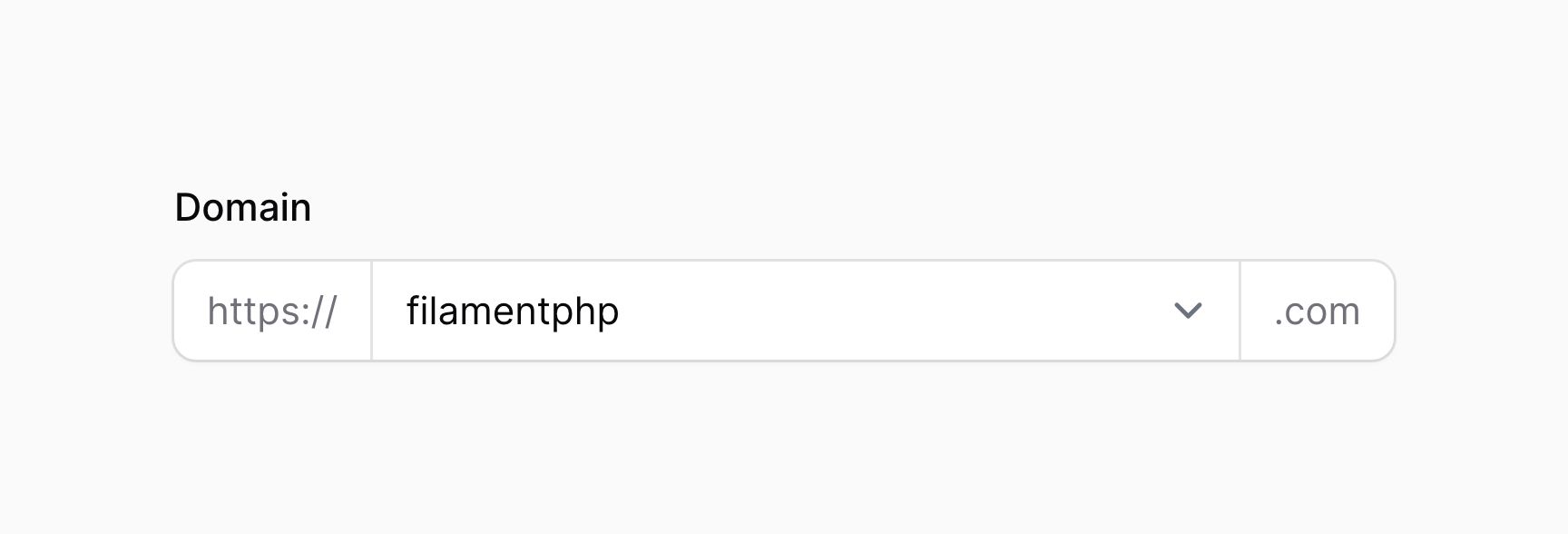
Using icons as affixes
You may place an icon before and after the input using the prefixIcon() and suffixIcon() methods:
use Filament\Forms\Components\Select;
Select::make('domain')
->suffixIcon('heroicon-m-globe-alt')
Setting a custom loading message
When you're using a searchable select or multi-select, you may want to display a custom message while the options are loading. You can do this using the loadingMessage() method:
use Filament\Forms\Components\Select;
Select::make('author_id')
->relationship(name: 'author', titleAttribute: 'name')
->searchable()
->loadingMessage('Loading authors...')
Setting a custom no search results message
When you're using a searchable select or multi-select, you may want to display a custom message when no search results are found. You can do this using the noSearchResultsMessage() method:
use Filament\Forms\Components\Select;
Select::make('author_id')
->relationship(name: 'author', titleAttribute: 'name')
->searchable()
->noSearchResultsMessage('No authors found.')
Setting a custom search prompt
When you're using a searchable select or multi-select, you may want to display a custom message when the user has not yet entered a search term. You can do this using the searchPrompt() method:
use Filament\Forms\Components\Select;
Select::make('author_id')
->relationship(name: 'author', titleAttribute: 'name')
->searchable(['name', 'email'])
->searchPrompt('Search authors by their name or email address')
Setting a custom searching message
When you're using a searchable select or multi-select, you may want to display a custom message while the search results are being loaded. You can do this using the searchingMessage() method:
use Filament\Forms\Components\Select;
Select::make('author_id')
->relationship(name: 'author', titleAttribute: 'name')
->searchable()
->searchingMessage('Searching authors...')
Tweaking the search debounce
By default, Filament will wait 1000 milliseconds (1 second) before searching for options when the user types in a searchable select or multi-select. It will also wait 1000 milliseconds between searches, if the user is continuously typing into the search input. You can change this using the searchDebounce() method:
use Filament\Forms\Components\Select;
Select::make('author_id')
->relationship(name: 'author', titleAttribute: 'name')
->searchable()
->searchDebounce(500)
Ensure that you are not lowering the debounce too much, as this may cause the select to become slow and unresponsive due to a high number of network requests to retrieve options from server.
Limiting the number of options
You can limit the number of options that are displayed in a searchable select or multi-select using the optionsLimit() method. The default is 50:
use Filament\Forms\Components\Select;
Select::make('author_id')
->relationship(name: 'author', titleAttribute: 'name')
->searchable()
->optionsLimit(20)
Ensure that you are not raising the limit too high, as this may cause the select to become slow and unresponsive due to high in-browser memory usage.
Select validation
As well as all rules listed on the validation page, there are additional rules that are specific to selects.
Selected items validation
You can validate the minimum and maximum number of items that you can select in a multi-select by setting the minItems() and maxItems() methods:
use Filament\Forms\Components\Select;
Select::make('technologies')
->multiple()
->options([
'tailwind' => 'Tailwind CSS',
'alpine' => 'Alpine.js',
'laravel' => 'Laravel',
'livewire' => 'Laravel Livewire',
])
->minItems(1)
->maxItems(3)
Customizing the select action objects
This field uses action objects for easy customization of buttons within it. You can customize these buttons by passing a function to an action registration method. The function has access to the $action object, which you can use to customize it or customize its modal. The following methods are available to customize the actions:
createOptionAction()editOptionAction()manageOptionActions()(for customizing both the create and edit option actions at once)
Here is an example of how you might customize an action:
use Filament\Forms\Components\Actions\Action;
use Filament\Forms\Components\Select;
Select::make('author_id')
->relationship(name: 'author', titleAttribute: 'name')
->createOptionAction(
fn (Action $action) => $action->modalWidth('3xl'),
)









